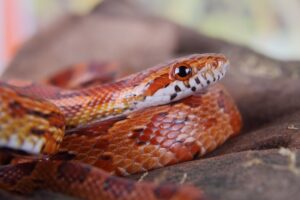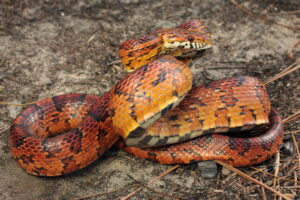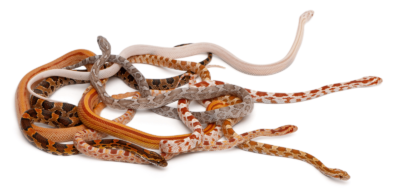Curious about keeping corn snakes as pets? One of the burning questions that often comes up is: how fast do corn snakes grow? It’s a fascinating topic, especially for new snake owners eager to understand the development of their scaly companions.
Corn snakes grow at a relatively fast rate, especially when they are young. A healthy corn snake that is consistently fed properly can grow around 12 to 18 inches per year for the first 2-3 years of its life. After that, their growth rate will slow down considerably.
In this article, we’ll dive into the growth process of corn snakes, shedding light on the factors that influence their development speed. Whether you’re a seasoned reptile enthusiast or just starting out, understanding how fast corn snakes grow is essential for providing them with the best care possible.
Anatomy and Physiology of Corn Snakes

Corn snakes (Pantherophis guttatus), popular reptiles in the pet trade, have fascinating anatomical and physiological features adapted to their environment and lifestyle.
- External Anatomy:
- Head: Typically triangular, with large eyes and nostrils. Heat-sensitive pits on the face help detect prey.
- Body: Elongated and cylindrical, covered in scales. Corn snakes are typically orange or reddish with blotches of darker coloration, resembling Indian corn, hence their name.
- Tail: Tapering, often brightly colored, and used for balance and stability.
- Internal Anatomy:
- Digestive System: Corn snakes are carnivorous, with a simple digestive tract. Their jaws can expand widely to swallow prey whole. Digestion is aided by stomach acids and enzymes.
- Respiratory System: Like other snakes, corn snakes have a simple lung system. They lack a diaphragm, so they rely on the expansion and contraction of muscles to breathe.
- Circulatory System: Corn snakes have a closed circulatory system with a three-chambered heart: two atria and one ventricle. This setup partially separates oxygenated and deoxygenated blood, making their circulatory system less efficient than that of mammals.
- Reproductive System: Corn snakes are oviparous, laying eggs rather than giving birth to live young. Females typically lay clutches of 10-30 eggs, which they incubate until hatching.
- Physiology:
- Thermoregulation: Corn snakes are ectothermic, meaning they rely on external sources of heat to regulate their body temperature. They bask in the sun or use heated rocks to raise their body temperature, and retreat to cooler areas to lower it.
- Feeding: Corn snakes are opportunistic feeders, primarily consuming rodents in the wild. They use constriction to subdue prey before swallowing it whole.
- Shedding: Like all reptiles, corn snakes shed their skin periodically as they grow. They rub against rough surfaces to help remove the old skin, revealing a fresh, vibrant layer underneath.
Understanding the anatomy and physiology of corn snakes is crucial for their proper care and husbandry in captivity. Providing appropriate temperature gradients, a varied diet, and adequate hiding spots mimicking their natural habitat helps ensure their health and well-being.
How fast do corn snakes grow?
Corn snakes are relatively quick growers, especially when they’re young. Here’s a breakdown of their growth rate:
- Hatchlings: These little guys start out small, typically between 8 and 12 inches long.
- Early Growth: During this stage, corn snakes will grow rapidly as they feed and develop. Feeding frequency plays a big role here – more frequent meals can accelerate growth.
- Maturity: As they reach adulthood (around 3-4 years old), their growth rate slows down considerably. They’ll still grow throughout their lifespan, but at a much slower pace.
- Adult Size: Full-grown corn snakes can range from 2.5 to 5 feet in length.
It’s important to note that some factors can influence a corn snake’s growth rate:
- Diet: As mentioned earlier, feeding them more often can lead to faster growth.
- Genetics: Just like any other animal, corn snakes have individual variations in growth due to genetics.
- Overall Health: A healthy snake with a proper environment will generally grow at a healthy pace.
If you’re considering getting a corn snake, keep in mind their adult size and plan accordingly. A properly sized enclosure is crucial for their well-being throughout their life.
Life Stages of Corn Snakes
Corn snakes, like many reptiles, go through distinct life stages as they grow and mature. Here’s an overview:
- Hatchling Stage:
- Corn snakes start their lives as hatchlings, emerging from eggs after an incubation period of about 60-65 days.
- Hatchlings are small, usually around 8-14 inches in length, and are quite fragile.
- They are often brightly colored and may exhibit variations in pattern and coloration depending on their genetics.
- Juvenile Stage:
- After hatching, corn snakes enter the juvenile stage, which lasts until they reach sexual maturity. This stage typically lasts for about one to two years.
- Juvenile corn snakes grow rapidly during this period, shedding their skin frequently as they increase in size.
- They require smaller prey items compared to adults and may need more frequent feeding to support their growth.
- Subadult Stage:
- As corn snakes approach sexual maturity, they enter the subadult stage. This stage usually occurs when they are around two to three years old, although it can vary depending on factors such as genetics, diet, and environmental conditions.
- Subadult corn snakes continue to grow, but at a slower rate compared to juveniles.
- They may start showing signs of sexual maturity, such as increased activity and exploratory behavior.
- Adult Stage:
- Corn snakes reach adulthood when they are sexually mature, typically between two to four years of age, depending on various factors.
- Adult corn snakes are fully grown, with females generally being larger and heavier than males.
- They are capable of reproducing, with females producing clutches of eggs during the breeding season.
Understanding the different life stages of corn snakes is essential for their proper care and management in captivity. It’s important to provide appropriate housing, diet, and environmental conditions tailored to each stage of their development to ensure they grow and thrive healthily.
Additionally, providing enrichment and stimulation can help keep them mentally and physically active throughout their lives.
Factors Influencing Growth Rate
Several factors influence the growth rate of corn snakes, both in the wild and in captivity. These factors can affect their development from hatchlings to adults. Here are some key factors:
- Genetics:
- Genetic factors play a significant role in determining the growth rate and size potential of individual corn snakes.
- Some genetic lines may naturally grow faster or larger than others, regardless of environmental conditions.
- Temperature and Environmental Conditions:
- Ambient temperature and environmental conditions directly impact the metabolic rate and growth rate of corn snakes.
- Optimal temperatures for growth vary depending on the snake’s life stage. For example, warmer temperatures generally promote faster growth in hatchlings and juveniles, while cooler temperatures may slow down growth but still support healthy development in adults.
- Feeding and Nutrition:
- Adequate nutrition is essential for healthy growth and development in corn snakes.
- Providing a varied diet of appropriately sized prey items and ensuring proper feeding frequency are crucial.
- Overfeeding can lead to obesity and other health issues, while underfeeding can stunt growth and development.
- Husbandry Practices:
- Proper husbandry practices, including enclosure size, substrate choice, humidity levels, and environmental enrichment, can influence the growth rate of corn snakes.
- Providing an adequately sized enclosure with appropriate hiding spots, climbing structures, and environmental stimulation encourages natural behaviors and contributes to overall health and growth.
- Sex and Sexual Dimorphism:
- Female corn snakes tend to be larger and heavier than males, which may affect their growth rates.
- Additionally, male corn snakes typically reach sexual maturity earlier than females, which can influence their growth trajectory.
- Health and Parasite Load:
- Health issues, such as infections or parasitic infestations, can impact the growth rate and overall health of corn snakes.
- Regular health checks, proper hygiene, and preventive measures against parasites are essential for maintaining optimal growth rates.
- Stress and Handling:
- Excessive stress or handling can negatively impact the growth and development of corn snakes.
- Minimizing unnecessary stressors and providing a secure and enriched environment can help promote healthy growth.
By considering these factors and providing appropriate care and husbandry practices, corn snake owners can help ensure that their snakes reach their full growth potential and maintain optimal health throughout their lives.
Monitoring Growth Progress

Monitoring the growth progress of corn snakes is essential for ensuring their health and well-being. Here’s how you can effectively monitor their growth:
- Regular Weighing:
- Weigh your corn snake regularly using a reliable scale appropriate for their size. Record the weight measurements in a journal or spreadsheet.
- A healthy corn snake should exhibit steady weight gain over time, especially during the juvenile and subadult stages.
- Measuring Length:
- Measure your corn snake’s length from the tip of its nose to the end of its tail.
- Record these measurements periodically to track growth progress. Corn snakes typically grow rapidly during the first few years of life and then slow down as they reach adulthood.
- Comparison to Growth Charts:
- Refer to growth charts specific to corn snakes to compare your snake’s growth progress with typical growth rates for its age and sex.
- Keep in mind that individual snakes may vary in growth rate, so use growth charts as general guidelines rather than strict rules.
- Visual Inspection:
- Regularly observe your corn snake’s overall appearance and body condition. Look for signs of proper muscle tone and healthy skin.
- Note any abnormalities such as weight loss, changes in appetite, or irregular shedding, which could indicate underlying health issues.
- Feeding Records:
- Keep detailed records of your corn snake’s feeding schedule, including the type and size of prey offered and whether the snake consumes the prey.
- Consistent feeding patterns and successful feeding responses are indicators of healthy growth and appetite.
- Behavioral Observations:
- Pay attention to your corn snake’s behavior and activity level. A healthy snake should be alert, active, and responsive to stimuli.
- Changes in behavior, such as lethargy or excessive hiding, may signal health problems that could affect growth.
- Consultation with a Veterinarian:
- If you have concerns about your corn snake’s growth or health, consult a veterinarian experienced in reptile care.
- A veterinarian can perform a physical examination, review your monitoring records, and provide guidance on optimizing your snake’s growth and overall well-being.
By consistently monitoring your corn snake’s growth progress and promptly addressing any concerns, you can help ensure that your snake remains healthy and thrives throughout its life.
Several growth-related issues can affect corn snakes, potentially impacting their health and development. Here are some common ones to be aware of:
- Malnutrition:
- Inadequate nutrition, such as feeding inappropriate prey items or offering prey that is too large or too small, can lead to malnutrition in corn snakes.
- Malnourished snakes may exhibit stunted growth, poor muscle development, and skeletal abnormalities.
- Obesity:
- Overfeeding or feeding prey items that are too large can lead to obesity in corn snakes.
- Obese snakes may have difficulty moving, reduced activity levels, and an increased risk of developing health problems such as fatty liver disease.
- Underfeeding:
- Insufficient feeding or offering prey items that are too small can result in underfeeding and slow growth in corn snakes.
- Underfed snakes may appear thin, lethargic, and may exhibit reduced growth rates.
- Metabolic Bone Disease (MBD):
- Metabolic bone disease is a common disorder in reptiles caused by calcium and/or vitamin D3 deficiencies.
- Symptoms of MBD in corn snakes include softening of the bones, skeletal deformities, and difficulty shedding.
- MBD can significantly impact a snake’s growth and overall health if left untreated.
- Parasitic Infections:
- Parasitic infestations, such as mites or internal parasites, can affect a corn snake’s ability to absorb nutrients from its food.
- Symptoms of parasitic infections may include weight loss, decreased appetite, lethargy, and abnormalities in fecal appearance.
- Respiratory Infections:
- Respiratory infections are common in reptiles and can result from improper environmental conditions, such as inadequate temperature or humidity levels.
- Symptoms of respiratory infections in corn snakes include wheezing, nasal discharge, open-mouth breathing, and reduced appetite.
- Chronic respiratory infections can hinder growth and lead to secondary health complications if not treated promptly.
- Environmental Stressors:
- Environmental stressors, such as inappropriate temperatures, humidity levels, or enclosure size, can negatively impact a corn snake’s growth and overall health.
- Stress-related issues may manifest as poor growth, decreased appetite, increased susceptibility to disease, and behavioral abnormalities.
It’s essential to monitor your corn snake closely for signs of these growth-related issues and address any concerns promptly. Providing a proper diet, suitable habitat, and regular veterinary care are crucial for promoting healthy growth and development in corn snakes.
If you suspect that your corn snake is experiencing growth-related problems, consult with a reptile veterinarian for a comprehensive evaluation and treatment plan.
Tips for Promoting Healthy Growth
Promoting healthy growth in corn snakes involves providing proper husbandry, nutrition, and care throughout their lives. Here are some tips to help ensure optimal growth and development:
- Provide a Suitable Enclosure:
- Choose an appropriately sized enclosure that allows your corn snake to stretch out fully and move around comfortably.
- Ensure the enclosure has adequate ventilation, secure closures, and escape-proof design.
- Include hiding spots, climbing structures, and other environmental enrichments to encourage natural behaviors and reduce stress.
- Maintain Optimal Temperature and Humidity:
- Provide a temperature gradient within the enclosure, with a warm side (around 85-90°F or 29-32°C) and a cooler side (around 75-80°F or 24-27°C).
- Use thermostats and reliable temperature/humidity gauges to monitor and regulate temperature and humidity levels.
- Provide a humidity level of around 40-60%, with occasional increases during shedding periods.
- Offer a Balanced Diet:
- Feed your corn snake a varied diet of appropriately sized prey items, such as mice or rats, according to its age and size.
- Consider offering pre-killed prey or frozen-thawed prey to reduce the risk of injury to your snake and minimize the transmission of parasites.
- Dust prey items with calcium and vitamin supplements as needed, especially for growing juveniles and breeding females.
- Monitor Feeding Frequency:
- Offer prey items appropriate in size to the girth of your snake’s body, typically once every 5-7 days for juveniles and once every 7-10 days for adults.
- Adjust feeding frequency based on your snake’s growth rate, appetite, and body condition to prevent underfeeding or overfeeding.
- Provide Clean Water:
- Ensure your corn snake has access to fresh, clean water at all times. Use a shallow water dish that is easy for your snake to access and cannot be tipped over.
- Replace the water daily and clean the water dish regularly to prevent bacterial growth and contamination.
- Minimize Stress:
- Handle your corn snake gently and minimally to avoid causing stress.
- Provide a secure and quiet environment free from disturbances, loud noises, and vibrations.
- Minimize changes to the enclosure setup and routine to reduce stress and promote a sense of security.
- Regular Health Checks:
- Monitor your corn snake’s growth progress, behavior, and overall health regularly.
- Keep records of weight, length, shedding, feeding, and any notable observations.
- Schedule regular veterinary check-ups to detect and address any health issues early on.
By following these tips and providing consistent care, you can help promote healthy growth and development in your corn snake, ensuring a long and fulfilling life.
Conclusion
How fast do corn snakes grow? Corn snakes typically exhibit rapid growth during their juvenile years, with their growth rate slowing as they reach adulthood. Factors such as genetics, diet, environmental conditions, and overall husbandry practices significantly influence their growth trajectory.
By providing appropriate care, nutrition, and a suitable habitat, corn snake owners can support healthy growth and development in their pets. Regular monitoring and adjustments to care routines ensure that these fascinating reptiles thrive throughout their lives.

